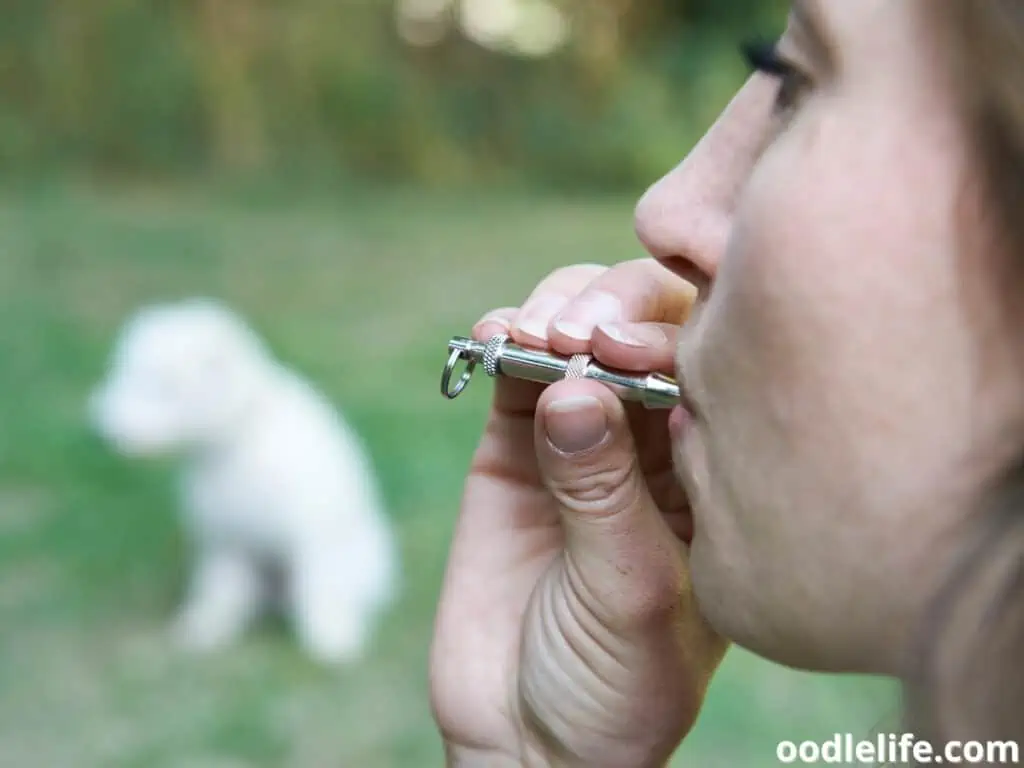How FAR Can Dogs Hear? (Wow!)
From getting to the door before the knock arrives to hiding under the covers before the thunder strikes, your dog’s ears catch things well in advance. And most dog owners are well aware of the fact that their dogs can hear better than them.
But if you’ve ever wondered just how better and how far can dogs hear, then you’ve come to the right place.

In this guide, we’ll help delve into the mystery that is the dog’s hearing sense and uncover the reason why our dogs can hear better (and just how much better) than us.
Before we get into the details of the process, here’s a quick answer to your burning question.
How Far Can Dogs Hear?
Dogs can hear sounds from between 80 feet to about a mile away. So what you can hear clearly from a 20 feet distance, your four-legged friend can hear from 80 feet away. This makes a dog’s hearing ability 4 to 5 times stronger than that of humans.

They do not just hear sounds from farther away but can also differentiate between various sounds and even pinpoint the exact source of the sound.
Their hearing ability also gets better or worse depending on the weather conditions, the pitch of the sound, distractions, wind, background noise, and more.
Now, let’s make one thing clear—you’re nowhere near listening in on the secret sounds that only dogs are privy to.
Why is that?
Keep reading to find out!
Why Can Dogs Hear Better Than Humans?
There is not one but many reasons as to why and how far dogs can hear. And most of these have something to do with the anatomy of dog ears and their inherent hearing ability.
Let’s see what these reasons are below:
1. Position of Ears
The biggest advantage dogs have over humans is the position of their ears.

Dog ears are positioned on top of their heads while those of humans stick flat at the side of their heads. Because of this, dogs can hear sounds from all directions better than humans, who hear sounds better from the direction their ears are turned toward.
2. Size of Ears
Dogs also have the advantage of larger ears that capture sounds more clearly. Although, not all dogs have large ears.

3. Ear Shape and Structure
Dogs have 18 muscles that work together to control their ear and contribute to their hearing capacity.

They can rotate, tilt, raise, and lower their ears to catch that faint distant voice of a favorite family member or a neighborhood dog.
That’s right. Every time your dog stops and moves their ears in this direction and that, they aren’t doing a weird face stretch. They’re controlling their ears to locate the source of the sound and hear better.
But that’s not all!
A dog’s ear is also structured to aid its hearing capabilities.
For starters, it is made up of three parts that are divided into the outer, middle, and inner ear.
The outer ear consists of the pinna. The pinna’s task is to capture and amplify sounds that hit the outer ear and transfer the sound to the middle ear.
The middle ear consists of the eardrum, the Eustachian tube, and three small bones called the ossicles. These transfer the sound to the inner listening organ.
The inner ear consists of the cochlea. It is the main hearing organ that processes sounds and also sends them to the brain.
4. Frequencies
Anyone who’s been around dogs long enough knows that dogs hate loud sounds of various kinds. It’s all due to the frequency of these sounds.

Apart from sounds at a distance, dogs can also hear sounds of a much higher frequency that is out of the human hearing range. That means humans cannot hear some things a dog can hear.
Frequencies are measured in Hertz (Hz). Sounds with a low frequency have a low Hz measurement, while higher notes have a higher measurement.
The human frequency range is between 64-23,000 HZ, and the dog’s range is between 67-45,000 HZ. This gives dogs better access to sounds that are inaudible to humans.
5. Loudness
Your furry friend can also hear sounds that are too soft for your ears. They can hear sounds with intensity as low as -5 dB to -15 dB. Humans can only hear sounds up to intensity as low as 0 dB.

The softer the sound, the lower its decibel (dB) rating.
Here are some noises that irritate your dog:
- Alarm clock – 90 dB
- Headphones – 100 dB
- City traffic – 85 dB
- Normal conversation – 60 dB
- Washing machine or dishwasher – 70 dB
- Nearby thunder – 120 dB
- Gunshot – 140 dB
- Air conditioner – 60 dB
- Lawn mower – 95 dB
6. Independent Listening and Filtering
Dogs, unlike humans, can filter out sounds to only hear what they want to.

This is because their ears can function independently of each other. So while they use one ear to listen to some distant sound, the other is paying attention to another sound nearby. This is a great skill that qualifies your canine to work in search and rescue missions.
The bottom line is that humans are pretty much stuck listening to the same sounds, while their furry counterparts have a rich world of auditory data to dive into all the time!
Why Can Dogs Hear So Well?
But why do dogs have this ability in the first place?

That’s because dogs’ ancestors, wolves, needed a strong hearing ability to hunt down their prey. Prey often included tiny rodents like mice that don’t make a lot of sounds when burrowing in and out of their little hideouts.
And although your dog isn’t hunting rodents in or around your house for a meal, it has retained its ability to listen in on their whereabouts. You can see this trait when your dog enjoys time chasing little animals in the neighborhood.
How To Tell If Your Dog Is Hearing Something?
While you cannot hear what your dog is hearing (no matter how badly you want to), you can tell when your dog is hearing something.

One sure-fire way to tell they’re trying to listen to something is by looking at their body posture. The dog will stop what it is doing and stand erect in an attentive position. Some dogs may simply shift to a more upright position from a seated position.
Another way to tell is by looking at your dogs’ ears. The flexible ears of these super listeners will move this way and that, then become erect and stay fixated in a position.
Once the dog has confirmed the source of the sound, it’ll either react to it by following it or barking in the direction. Or it may simply lose interest and go back to its previous activity.
Whatever the reason, it is an interesting spectacle to watch and get to know your pet better. It may also help you learn how to calm your dog in time before its fight-or-flight response kicks in.
How Do Dogs Hear Different Sounds?
Human Voice
The human voice range is between 350 – 3,000 Hz and has a loudness of 60 dB during everyday conversations. This is within the range of a dog’s hearing.

So if you find your dog not listening to you from across the same room, they’re probably ignoring you even though they hear you pretty clearly. This is also why shouting is traumatic to dogs and must be avoided at all costs.
Dogs also tend to hear female voices better from a distance because females are more likely to have a high-pitched voice than males.
Do Dogs Understand What We’re Saying?
While dogs may not understand what you’re talking about, they can detect tones very well. They combine the tone and volume of the human speaking to deduce meaning and emotion.
What’s more?
Your beloved pet can even tell that it’s you, whether you’re calling from the living room or a video call.
Whistle
But what about whistles?

Dogs can hear whistles from around 400 yards away. That’s because whistles have a range of between 23,000-54,000 Hz.
That’s one of the few reasons why dog whistles are used in dog training to help give dogs the command to do a particular activity.
Whistles can also be of a certain frequency and loudness that only dogs can hear. This makes them easy to use during dog training without disturbing others or shouting at the top of your lungs.
But take care not to use a whistle when the dog is close to you. Whistles are high-pitch sounds that can hurt the dog’s ears and even terrify them.
Thunder
Dogs can detect thunderstorms about 15 to 20 minutes before they happen. That’s because thunderstorms have a 100-115 dB range that’s way out of the safety range for your canine.

Dogs can sense thunder with both their ears and their noses.
Thunderstorms appear simple to humans, but a lot happens during one. There is thunder, lightning, wind, static electricity, barometric pressure change, and low-frequency rumbling.
While these often go undetected by the human senses, a dog’s senses pick up on them and are why your dog can appear overwhelmed.
Fireworks
Dogs can hear fireworks from 3 times the distance that humans can.

Fireworks have a high-pitched sound between 140-150 dB that dogs can hear (painfully) well. They are perceived as a threat by dogs, triggering their flight or fight response.
This is why you may find your dog hiding under the covers or barking incessantly during a thunderstorm. Fireworks may also cause pain and lead to an ear injury, which may be why your dog reacts so vehemently to them.
Breeds and Their Hearing Ability
Despite the fact that most canines have a better hearing capacity than humans, not all dogs are equally good at hearing.

Dog breeds with erect ears hear better than breeds with floppy ears. Similarly, breeds with little hair inside their ears hear better than those with hairy ears.
If you’re looking for a super listener dog breed among the rest or simply want to see how well your dog hears in comparison, here’s a list of dogs with the best hearing:
- Cocker Spaniels
- Poodles
- Golden Retrievers
- Labrador Retrievers
How To Take Care of Your Dog’s Ears?
A dog’s ear and hearing capacity are affected by a number of factors, including aging, infections, and deafness. While there’s little you or anyone can do about aging, infections and deafness are different cases.

To prevent deafness due to loud noises, it is best to take proper precautions to protect your dog’s ears, especially when you’re going to or live in a place with lots of noise pollution.
As basic upkeep, you can also regularly clean your dog’s ears with an ear cleaning solution.
Note that breeds with white fur are more prone to ear infections and congenital deafness. If you have any of these breeds, you may want to get their hearing tested from time to time:
- Dalmatian
- Bull Terrier
- Jack Russell Terrier
- Australian Cattle Dogs
If you’re worried about your dog’s existing hearing condition, take them for a Brainstem Auditory Evoked Response (BAER) hearing test. It’ll give you a good clue about their hearing abilities or deterioration.
In Conclusion
Dogs can not only hear things from farther away but also hear things humans can’t.
How far can dogs hear? Enough to call it one of their many superpowers.
From locating a family member from yards away to learning of home invaders before anyone else, the dog’s hearing sense is a blessing.
We hope this guide will help you take better care of your dog and its ears wherever you go. Your dog should be safe as long as you use sufficient caution and don’t exceed the safe sound level.